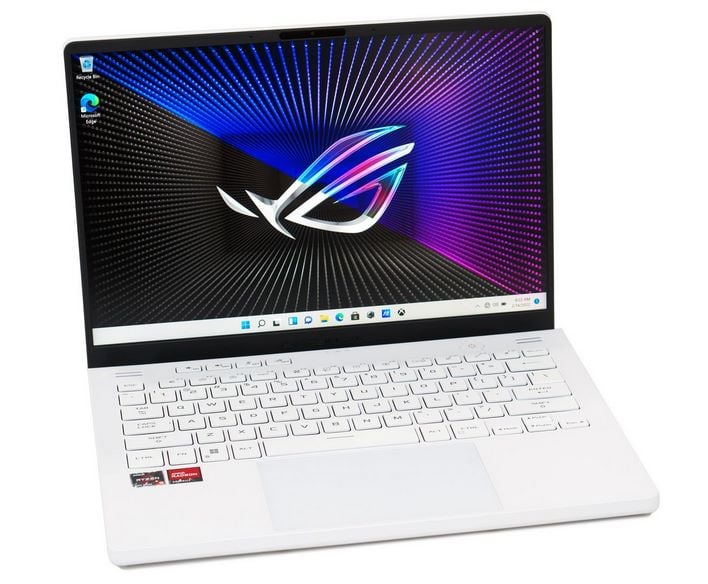Ryzen 6000 And ASUS ROG Zephyrus G14 Laptop Review: Revisiting Performance
ASUS ROG Zephyrus G14: Thermals, Acoustics, Performance Update And The Verdict
The ROG Zephyrus G14 has multiple personalities in regards to its thermals and acoustics. Like most modern laptops, the system switches into different power modes, depending on the use case. Although you can alter this with a couple of clicks, the ROG Zephyrus G14 switches into Quiet mode when on battery, which scales back the processor’s frequency and voltage curve, limits framerates, and also prevents the fans from spinning up too high. The default Performance mode has more bite when under load, and the fans can spin up fast enough to produce a fair amount of noise. At idle though, the fans spin down completely in both Quiet and Performance modes. Turbo mode goes all out, however, and allows for higher power levels, and higher fan speeds. In Turbo mode, the fans also spin all the time, even at idle.
ASUS ROG Zephyrus G14 Thermal And Acoustic Performance
In Quiet mode, the machine if rather tame acoustically. It’s effectively silent at idle and under light loads. When the fans do spin up in Quiet mode, the ROG Zephyrus G14 barely registered over 41dB on our meter, with it placed about a foot away from the display.In performance mode, the acoustic output from the fans ramps up considerably. Under a sustained, heavy workload, with the fans spinning at their max, we registered between 47 – 48dB on our meter. That’s not bad in light of other gaming notebooks. However, again the noise floor can fluctuate greatly, depending on the power mode.
When maxed out in Turbo mode and place under a heavy, sustained load, things can get a little louder. The ROG Zephyrus G14 flirted with the 53dB mark in our tests. The acoustic report is also somewhat high pitched, which may be off-putting for some. For a machine of this size, and with the kind of performance it offers, the ROG Zephyrus G14’s noise output is in-line with competing systems.
As you would expect, temperatures also ramp differently depending on what power mode the system is using. Quiet mode is the tamest, while Turbo mode is the most aggressive.
Internal temperatures are what you would expect as well. We’ve got some hardware health data to show you what we mean.
This is the hardware health data captured during a couple of 3DMark Time Spy runs – and this was taken after many hours of benchmarking. The top plot is in Performance mode, the bottom one in Turbo mode. As you’ll see, CPU frequencies remain relatively consistent and GPU temperatures, peak under 90°C.
We also have some CPU-related data captured during a PCMark 10 run. What you see here are relatively consistent CPU frequencies across all of the tests, with lots of peaks and valleys in terms of power consumption. Unfortunately, UL’s tools weren’t capturing CPU temperatures across the plot, but we can report that the Ryzen 9 6900HS in the ROG Zephyrus G14 is well behaved. According to ASUS’ Amory Crate app, the CPU temperatures will reach the mid-to-upper 90’s when initially under a heavy load, just like most of the today’s high-end notebooks, but the cooling fans will then kick in and drag temps down.
The inevitable swings in performance that this can sometimes bring to a notebook are not present on the ROG Zephyrus G14, however. Unlike some systems that will bleed off performance when under long sustained loads, the ROG Zephyrus G14’s performance remains consistent. In fact, after 10 consecutive Cinebench runs, scores were higher on some of the later passes through the benchmark.
ASUS Zephyrus G14 June Performance Update
When evaluating laptops built around brand new mobile platforms, we often have to endure multiple software, firmware, and BIOS updates over the course of testing, while all of the parties involved in the launch work out various the kinks and bugs that crop up when systems are out in the wild, and as they optimize performance of the system.Since our initial review hit, the ASUS Zephyrus G14 for 2022 has received a couple of BIOS updates, a new VBIOS, updated monitor calibration profile, and numerous firmware and driver updates for various other components within the system. Microsoft has released a number of updates and patches for Windows 11 as well. ASUS has released freshly minted versions of its Armory Crate and My ASUS utilities. And AMD has released new chipset and graphics drivers too.
Due to the wide array of updates that have arrived for the Zephyrus G14, we thought it would be an interesting exercise to re-run a handful of benchmarks to see if the system’s performance has changed significantly – for better or worse. While the hardware hasn’t changed, the fast majority of the software is different. What does that mean for performance? Let’s find out...
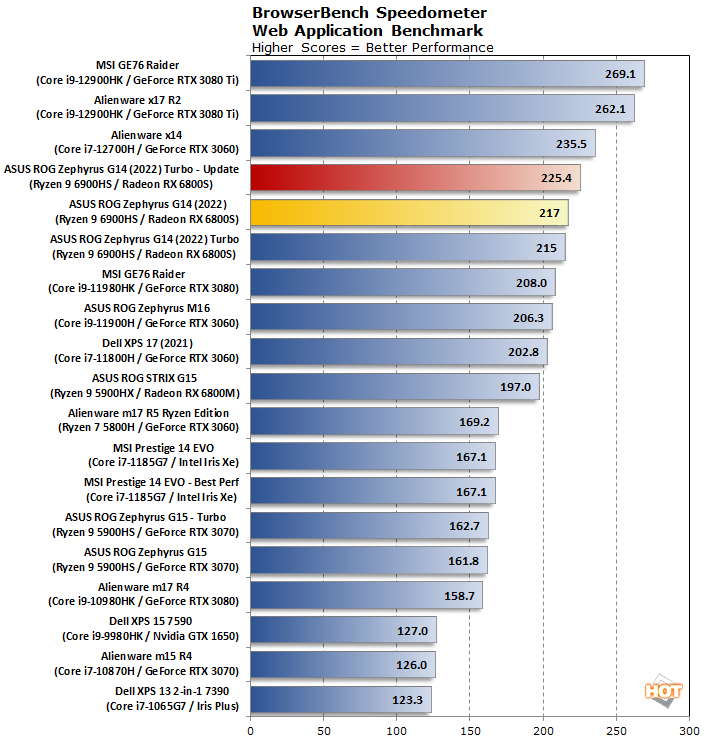
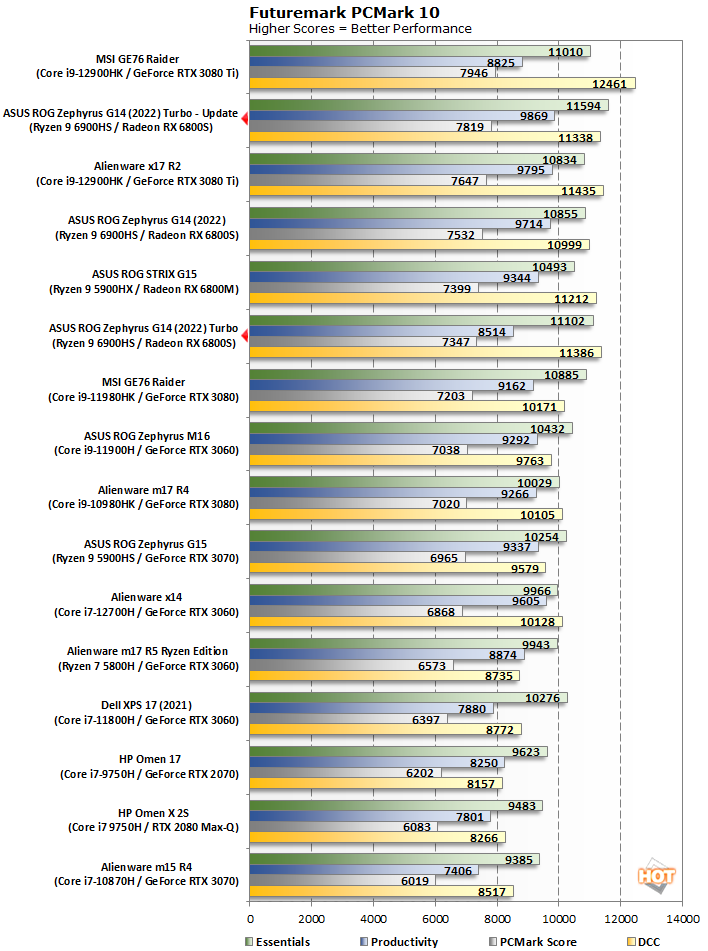

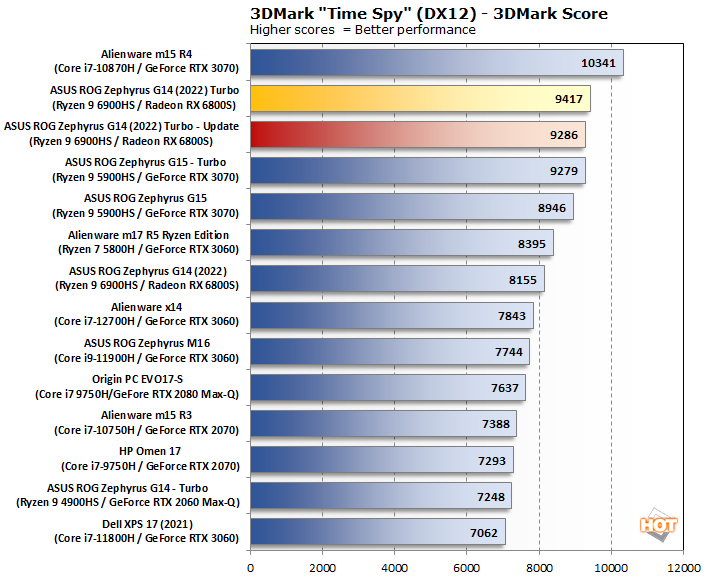
Retesting the Radeon RX 6800S resulted in a slight performance decrease, but we're talking about a relatively small difference that falls within the margin of error in this test.
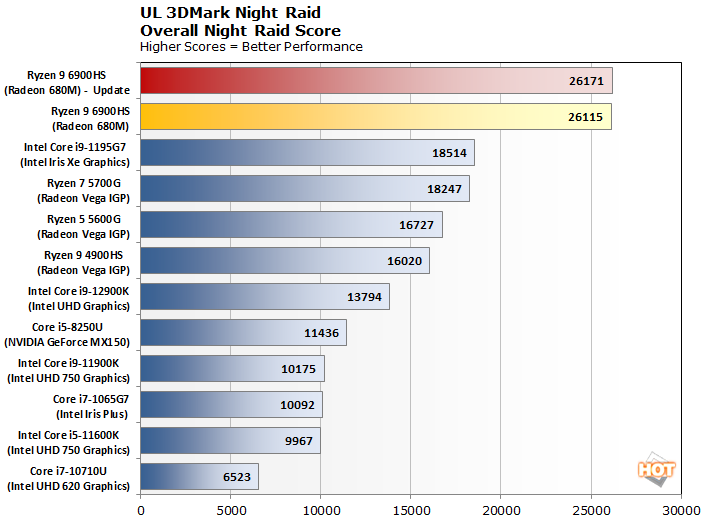
ASUS Zephyrus G14 With Ryzen 6000: The Verdict
The ASUS ROG Zephyrus G14 will be available in multiple configurations today, from a few key retailers. The Ryzen 9 6900HS + Radeon RX 6800S configuration we tested, with 32GB of RAM, WQXGA 120Hz display, in Moonlight White with AniMe Matrix display, has an MSRP of $2,499. That’s not chump change by any means, but considering the high-performance and relatively small form factor of this system, it’s easily justifiable in the current market environment. Personally, as cool as it is, we’d opt for a model without the AniMe Matrix display to save a few bucks, but if you dig the light show and customization, you do you.AMD's Ryzen 9 6900HS proved to be a strong performer overall. In the CPU-centric tests, it wasn’t able to overtake Intel’s latest Alder Lake-based 12th Gen chips in most tests, but keep in mind the 6900HS is a mid-range Ryzen 6000-series processor and its inside a 14” notebook here. Even still, it competes well with the latest laptops on the market, and in its default configuration it does so at lower power levels. AMD's new Radeon RX 6800S also competes well, typically trading blows with GeForce RTX 3070 / RTX 3060 mobile-equipped systems.
Perhaps the unsung hero of the performance story is the Radeon 680M iGPU. In a system like the ASUS ROG Zephyrus G14, the discrete GPU will be put to use in gaming and heavy workloads, so the Radeon 680M will only be tasked with lighter-duty stuff. But as our tests showed on the previous page, the Radeon 680M is very powerful for an integrated GPU. It blew Intel’s Xe graphics out of the water and smoked the desktop Vega-based variant in the Ryzen 7 5700G. This bodes extremely well for future thin-and-light laptops that won’t have discrete GPUs.
All told, there’s a lot to like here. Ryzen 6000 series processors and the latest mobile Radeons make a great combination. Overall performance many not top the charts across the board, but the A+A AMD Advantage ASUS ROG Zephyrus G14 machine we tested here punches well above its weight class and offers an excellent experience. If you’ve been considering a smaller-form-factor gaming notebook, with the chops to handle virtually any workload, we can easily recommend that the Ryzen 6000-powered ASUS ROG Zephyrus G14 should be added to your short list.

 |
 |
||
|
|






